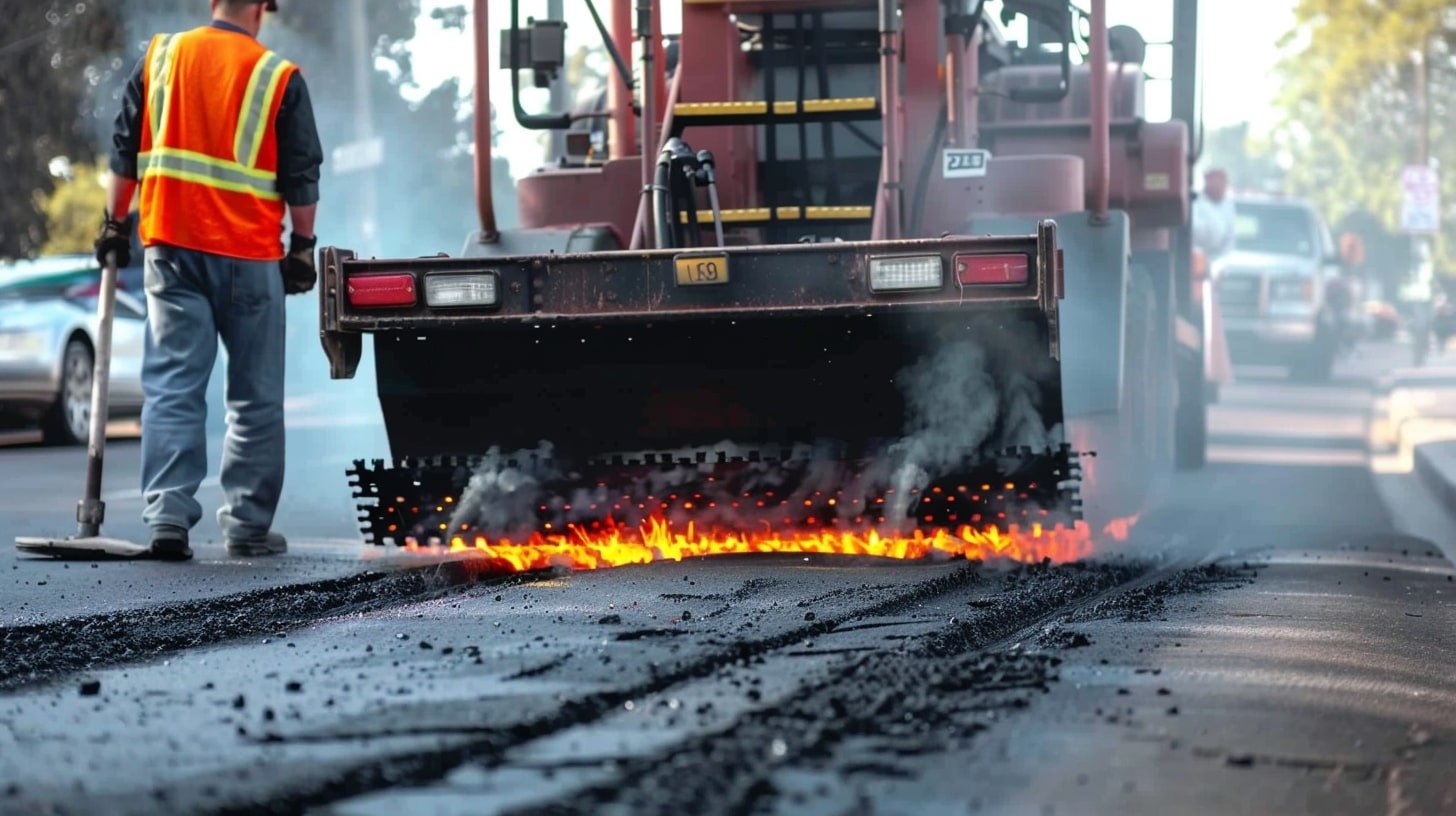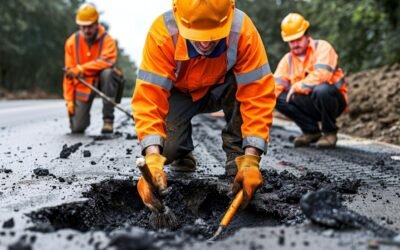Potholes are more than mere annoyances; they’re a symptom of decaying infrastructure and have a profound impact on vehicle safety and public budgets. Traditional pothole repair techniques, such as cold patching and hot mix asphalt filling, are often seen as a temporary fix, leading to repetitive maintenance costs. Enter innovative infrared pothole remediation, a technology that promises not only to streamline the repair process but also to provide a more durable and cost-effective solution.
Table of Contents
What are Infrared Pothole Remediation Techniques?
Infrared pothole repair (IRR), is a cutting-edge road repair method that utilizes infrared technology to heal cracks and cavities in the pavement. Unlike conventional methods, the infrared process recycles existing asphalt by heating it to a workable state. This process not only repairs the pothole but also seamlessly fuses the repair site with the surrounding pavement. The key to this technique lies within its specialized equipment, which includes an infrared heating panel, temperature control systems, and an asphalt processor.
Key Takeaway: Infrared pothole remediation harnesses the power of controlled heat to recycle asphalt, offering a repair synonymous with the original pavement.
The main steps in the infrared process involve:
- Heating: The infrared heating panel raises the temperature of the damaged asphalt and a small surrounding area.
- Reprocessing: The heated asphalt becomes malleable, allowing for manipulation and mixing with new or reclaimed asphalt.
- Compacting: After reworking, the asphalt is compacted to create a seamless and smooth finish.
This method is gaining recognition due to its environmental efficiency. By recycling the existing asphalt, infrared remediation minimizes waste — a significant benefit for eco-conscious municipalities. The technique also allows for repairs under various weather conditions, extending the repair season beyond traditional limitations.
Crucial aspects governing the success of infrared techniques include:
- Correct temperature control to prevent asphalt overheating and scorching.
- Proper training for operators handling the highly specialized equipment.
- Construction standards compliance to ensure safety and quality of the repair.
For a visual representation of how infrared technology works in pothole repair:
With its rise in popularity, many cities across Canada are adopting infrared technology for their road maintenance programs. This has led to a surge in available equipment and professional training courses designed to upskill road repair workforces with the necessary expertise to manage these advanced systems.
Despite its growing user base, infrared technology is still underutilized in certain regions, primarily due to lack of awareness and conventional practice inertia. By showcasing tangible benefits through real-life examples and empirical data, this perspective on road repair can reach a wider audience and drive more widespread adoption.
In summary, infrared pothole remediation techniques represent a smart solution to the perennial problem of potholes. Effectiveness and efficiency are at the heart of this modern approach, offering a sustainable and superior alternative to traditional pothole repair methods.
The Benefits of Infrared Pothole Repair
Cost-Efficiency
The cost-saving potential of infrared pothole repair is significant compared to traditional methods. By reusing existing asphalt, the need for purchasing new materials is reduced, cutting down expenses. Moreover, the need for repeated repairs and associated traffic disruptions — which are often seen with short-term fixes like cold patching — are greatly diminished. This presents a long-term saving to public budgets, emphasizing the economic viability of infrared techniques.
Longevity of Repairs
Data suggests that infrared repairs, when properly executed, can last several years, outlasting those done by traditional methods. This longevity stems from the thorough integration of the repair material with the surrounding pavement, creating a monolithic patch that is less susceptible to the cold-water cycles that often cause pothole reformation. Credible, peer-reviewed studies confirm that longer-lasting repairs translate to reduced intervention frequency and better road conditions over time.
Environmental Impact
The environmental advantages of infrared repairs are multifold. Not only does it reduce material waste but also cuts down on the carbon emissions associated with the production and transportation of new asphalt. The ecological footprint of road maintenance is thus substantially minimized, aligning with the increasingly stringent policies on sustainable urban development.
Speed and Convenience
An infrared repair can be completed in less than half the time required for traditional methods, leading to quicker reopening of roads and minimized traffic disruption. The compact nature of the equipment used means fewer crew members are needed, and repairs can be effected without the need for large work zones. This convenience translates to higher efficiency in addressing pothole problems soon after they appear, which is critical to maintaining road safety.
Fun Fact: In some cases, an infrared pothole repair can be executed in just 20 minutes — less time than it takes to watch an episode of a sitcom!
Despite the clear benefits, there are still challenges that prevent the widespread adoption of infrared technology. These include up-front investment in equipment, skepticism from decision-makers accustomed to traditional methods, and a general lack of awareness. Addressing these challenges head-on can pave the way for more sustainable infrastructure and present a compelling case for departments and municipalities to re-evaluate their road maintenance strategies.
How Infrared Pothole Remediation Works
The process of infrared pothole remediation revolves around a few critical steps, each reliant on the precision and efficiency of infrared technology to restore the roadway surface. From preparation to finishing, the technique engages a methodical approach to ensure the integrity and durability of the repair. Here’s a closer look at each step in the process:
Preparing the Pothole Area
Before the infrared technology is deployed, the area around the pothole must be cleared of debris and standing water. This step is crucial because a clean work area ensures optimal adhesion and fusion of the recycled asphalt.
The Infrared Heating Process
Once preparation is complete, the infrared heater is positioned over the pothole. The next critical phase is the application of carefully controlled infrared heat, which softens the existing asphalt to a depth of about 50mm. Technicians carefully monitor the temperature to prevent any damage to the asphalt structure, aiming for a perfect balance that allows for the next step — asphalt manipulation.
Asphalt Recycling and Application
With the heated asphalt now pliable, workers can add fresh or reclaimed asphalt into the mix. They then rake and blend the materials to create a uniform, seamless repair with no joints or edges that could allow for water infiltration and future decay.
Compaction and Finishing
The final step involves compacting the hot asphalt mixture to conform to the existing road surface profile. Correct compaction ensures there will be no settling or displacement, which are common culprits behind pothole reformation. The compacted repair is then allowed to cool, resulting in a smooth, integrated patch that is often indistinguishable from the original roadway.
Understanding this procedure can instill confidence in the transformative benefits it offers. Advanced training for operators and strict adherence to safety protocols are imperative to achieve the high-quality results that infrared pothole remediation promises.
Comparing Infrared to Traditional Pothole Repair Methods
Limitations of Traditional Methods
Traditional methods like cold patch and hot mix are often viewed as a quick fix, failing to offer longevity due to their surface-level application. Cold patches can loosen, becoming a hazard; hot mix repairs take time to set, disrupting traffic and often leading to a rough finish.
Infrared vs. Traditional: A Side-by-Side Comparison
When directly compared, the advantages of infrared become clear. Whereas traditional repairs might last a few months to a year, infrared repairs have the potential to extend the life of the pavement for several years. Moreover, the ability to perform repairs quickly with infrared technology reduces labor costs and limits traffic disruption.
Fun Fact: Did you know that infrared repairs create a thermal bond with the surrounding asphalt, virtually eliminating the seams that are the weak points of traditional repairs?
Choosing the Right Equipment for Infrared Pothole Repair
Essential Equipment Features
Selecting the proper equipment is critical for efficient infrared repairs. Features such as adjustable heating zones, temperature control, and timers are crucial for ensuring consistent results. The ideal equipment should be user-friendly and require minimal maintenance.
Safety and Training Considerations
Safety must never be compromised. Operators should be provided with comprehensive training, not just on using the equipment, but also on recognising asphalt conditions suitable for infrared repair. Proper personal protective equipment (PPE) must always be worn to protect workers from the intense heat produced by the heaters.
Key Takeaway: Well-trained personnel and the right tools are paramount to maximizing the benefits of infrared pothole repair, ensuring safe and effective road maintenance.
Conclusion
This exploration of innovative infrared techniques for pothole remediation has shed light on its many benefits, from cost savings and environmental impact, to the longevity and effectiveness of repairs.
Adopting this technology is not simply about enhancing road repair methods; it’s a statement about prioritizing sustainability, efficiency, and forward-thinking in public service delivery. While conventional methods have served their purpose in the past, the advancement of infrared techniques offers an opportunity for municipalities to do more than just patch up problems—it’s a chance to create lasting improvements to our vital transportation networks.
For policymakers, road maintenance crews, and community stakeholders, it is now an optimal time to consider how infrared pothole repair can transform the approach to managing our roads. By embracing this innovative method, communities can not only address the perennial issue of potholes but also demonstrate a commitment to technological adaptation and fiscal responsibility.
Ultimately, the switch to infrared is more than a technical decision—it’s a strategic move towards building more resilient infrastructure that can stand the test of time and weather. As cities continue to grow and evolve, the need for durable, efficient, and eco-friendly solutions becomes not just an option, but a necessity. In the face of this need, infrared pothole remediation shines brightly as a path to a smoother future for all road users.
Let’s drive the change forward—by advocating for the advancement of our infrastructure, we can guarantee safer, more dependable roads for generations to come.
FAQs
- How long does an infrared pothole repair last compared to traditional methods?
Infrared pothole repairs can last several years, which is longer than many traditional methods such as cold patching, which may only last a few months to a year under similar conditions. The longevity of an infrared repair is due to the thermal bonding that occurs between the repair material and the old asphalt, creating a durable, monolithic patch. - Can infrared technology be used in all weather conditions?
While infrared technology is versatile, extreme weather conditions such as heavy rain or snow can interfere with the repair process. However, it generally allows for a longer repair season compared to traditional methods, as the technology can effectively be used in colder temperatures where traditional hot mix would not be viable. - What sizes of potholes can be repaired using infrared techniques?
Infrared techniques are suitable for a wide range of pothole sizes, from small to large. The key factor is the size of the infrared heating unit, which can be selected based on the typical pothole sizes encountered. For very large repairs, multiple passes with the heating unit may be necessary. - How does the public perceive infrared pothole repairs?
Public perception of infrared pothole repairs tends to be positive, primarily due to the reduced disruption to traffic and the longevity of the repairs. Also, the public often appreciates the eco-friendly aspect of the process due to the recycling of existing asphalt and reduced waste. - Are there grants or governmental support available for adopting infrared technology?
Various grants and funding opportunities may be available to municipalities and governing bodies interested in adopting infrared technology, especially those that prioritize sustainability and innovation. Interested parties should research local, provincial, and federal programs for potential financial support related to infrastructure improvements.







